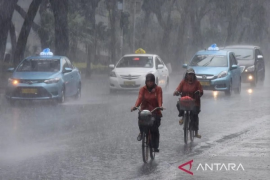Jakarta (Antara Bali) - Despite the increase in the number of female candidates in the
parliamentary elections held throughout Indonesia on April 9, 2014, the
country would likely fail to meet its target of increasing womens
representation in the 560-seat Parliament for the 2014-2019 period.
Of 6,607 legislative candidates racing for the House of
Representatives (DPR) seats in the elections, some 37 percent or 2,467
were women, up from 30 percent in the legislative elections in 2009.
On May 9, the General Elections Commission (KPU) announced the
official results of the legislative elections, with the Indonesian
Democratic Party of Struggle (PDIP) in first place, winning 18.95
percent of the votes.
In a plenary meeting on the conversion of votes to parliamentary
seats in Jakarta, May 14, 2014, KPU Chairman Husni Kamil Manik announced
the names of 560 candidates elected to the DPR.
They will be officially sworn in as members of the Parliament in October 2014.
KPU Commissioner Hadar Nafis Gumai after the plenary meeting said,
of the 560 people, only 94 were women, or around 17 percent, or a drop
from 101 elected female candidates in the DPR for the 2009-2014 period.
The 2009 general election saw the highest percentage in Indonesian
history of female lawmakers taking up sets at the DPR, with more than 18
percent of the total 560 seats.
Among those likely winning the seats include incumbent former TV
presenter Meutya Hafid from Golkar Party, actress Rieke Diah Pitaloka
and Puan Maharani from the Indonesian Democratic Party of Struggle
(PDI-P), and actress Vena Melinda from the Democratic Party. While,
actress Desy Ratnasari from the National Mandate Party (PAN) is elected
as an MP for the first time.
A disappointment was earlier voiced by Ana Margret, the deputy
director of the University of Indonesia (UI)s Political Study Center,
who predicted even fewer number of women in the 2014-2019 Parliament.
She estimated that the number of female lawmakers in the Indonesian
Parliament would drop significantly from over 18 percent women in
2009, to 14 percent or 79 women this year.
In a seminar on "Critical Reflection of the Political Parties
Commitment to Elected Female Legislators" held in Jakarta recently, she
said the decline should be critically assessed since it ran contrary to
the fact that 37 percent of the legislative candidates participating in
the 2014 elections were female, up from 33.6 percent in the 2009
elections.
She predicted that most of the elected female legislators were
newcomers to Parliament. Only 34 percent managed to maintain their
seats; the rest have left Parliament, she stated. "Of the 103 female
lawmakers in Parliament for the 2009-2014 period, only 36 are believed
to have been re-elected," she noted.
Similar to predictions regarding all legislative candidates for the
House, 30 of the 79 women - or 39 percent - had family connections to
incumbent members of local legislative bodies, governors and regents,
said Anna Margret.
The Center also found that although the Indonesian Democratic Party
of Struggle (PDI-P) won the legislative election with over 18 percent
of the popular vote, it was the United Development Partys (PPP) women
candidates who gained the most votes among women or 22.33 percent across
75 electoral districts, while the party that secured the lowest number
of votes for its women candidates was the Prosperous Justice Party (PKS)
with 13.20 percent.
To increase the womens representation in the Parliament, the KPUs
regulations mandate that female legislative candidates should comprise
at least 30 percent of the total candidates. The UIs research, however,
indicated that this regulation did not automatically secure the ideal
quota of female legislators, she stated.
According to article 55 in the Electoral Law 10/2008, regarding
elections to the Indonesian Parliament, "at least one in every three
candidates included on a political party list should be women." It is
expected that by applying this acquisition, political parties may
fulfill the 30 percent quota for women, both in the national and local
parliaments, in line with international agreements.
Of Indonesias total population of over 245 million people, women
occupy around 18.2 seats in the Parliament based on the results of the
2009 general elections.
While, based on the World Bank 2011 data, women constitute 50.14
percent of the countrys total population. Previously, from the 2004
general elections, the representation of women in the Indonesian
parliament was just almost 11 percent.
Fifteen political parties consisting of 12 national-level
political parties and three local parties, participated in the
legislative elections on April 9, 2014.
The 12 parties are National Democratic Party (Nasdem), National
Awakening Party (PKB), Prosperous Justice Party (PKS), Indonesian
Democratic Party of Struggle (PDIP), Golkar Party, Gerindra, Democratic
Party (PD), National Mandate Party (PAN), United Development Party
(PPP), Hanura, Crescent and Star Party (PBB), and Indonesian Justice and
Unity Party (PKPI).
The three local parties are Acehs Peace Party (PDA), Acehs National
Party (PNA), and Aceh Party (PA) - all of them are in the special
autonomous province of Aceh Darussalam, Indonesias northern most
province.
All 15 parties met the quota of at least 30 percent for women
candidates. For instance, PKS proposed 193 women or about 38 percent,
NasDem with 223 people or 39.82 percent were women, Hanura Party with
199 women or 36 percent, and PAN 208 women or 37 percent.
Women rights activists, however, criticized that most male
political party bosses stuffed their nomination lists with models,
actresses and their daughters and wives just in order to meet the
legally mandated 30 per cent quota for female representation on
candidate lists.
"Too many of the women selected by political parties are celebrities or the relatives of strong political dynasties,"
Titi Anggraini, executive director of Perludem, an independent election watchdog, was quoted by the Jakarta Post as saying.
However, a number of people believe that it is quality rather than quantity that matters.
"There is no problem if the number of women in the DPR is small,
provided that they are qualified and can serve the people," Dewi Motik
Pramono, the general chairperson of the Indonesian Womens Congress
(Kowani), stated recently.
"The quota of 30 percent seats in the DPR is meaningless if they
are not qualified. Can we mention how many qualified woman legislators
are there in the House now? For me, it will be better to have 20 or 30
female legislators in the House as long as they are qualified," Motik
added. (WDY)
Indonesia Likely To Have Fewer Women In Parliament
Senin, 19 Mei 2014 9:31 WIB







